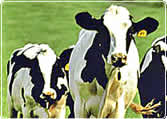Pollution
Agriculture – methane
Methane (CH4) is the second most
important greenhouse gas which
could contribute to global warming
and climate change. In the last two
centuries, methane levels in the
atmosphere have doubled, largely
due to human activities.
The rows in the table right highlighted in green are associated with agriculture (33% of emissions)
Figures are from the Institute on Climate and Planets, GISS,NASA.
Agricultural sources:
- Farm animals such as sheep and cows produce significant quantities of
methane which they ‘belch’ from their digestive system.
They have a digestive system
consisting of four stomachs. Three of these contain ‘friendly’ symbiotic micro-organisms
that help them to digest cellulose and produce methane as a waste product. The animals
that have this type of digestion ‘chew the cud’ or regurgitate their food for further chewing
and are known as ruminants.
- Growing rice as a source of food is globally very important and the
staple diet for billions of people. Most rice is grown in water (paddy fields) and like wetlands,
the micro-organisms in the mud produce methane as they break down organic matter in
anaerobic (without oxygen) conditions.
|
Methane sources are:
| Natural emissions |
Wetlands |
22% |
Termites |
4% |
From oceans |
3% |
| Anthropogenic (man made ) emissions |
Natural Gas from oil fields |
19% |
From ruminant stomachs |
16% |
Rice cultivation (paddy fields) |
12% |
Biomass burning |
8% |
Landfill sites |
6% |
Sewage treatment |
5% |
Animal waste |
5% |

|
- Organic animal waste from farms mainly comes in the form of FYM (farm yard manure) and slurry, and it can be a major problem for a farmer, especially if it is a dairy farm. The slurry is
 normally stored in a large pit where it undergoes a natural breakdown process converting ammonia waste and organic matter into useful forms (nitrates) which can then be put back onto the fields. During this process methane is produced along with other gases such as ammonia.
normally stored in a large pit where it undergoes a natural breakdown process converting ammonia waste and organic matter into useful forms (nitrates) which can then be put back onto the fields. During this process methane is produced along with other gases such as ammonia.
Most modern farms will recycle this waste by returning the nutrients to the soil. Raw slurry is toxic and has to be broken down before it can be put back onto the land.
- Some figures (Click here for the Source)
- Estimated 200 million tonnes undiluted excreta produced annually in UK
- 60% of this from grazing livestock, voided straight to grassland
- Remaining 80 million tonnes collected from buildings for storage and spreading
Of this 50% handled as solid manure, 50% as slurries
- Majority of total quantity of excreta is produced by cattle
- Virtually all livestock waste is recycled to the land
- Solutions:
The obvious solution is to cut back on agricultural practices that produce methane, which is clearly an impractical suggestion. Why?
Capturing the methane from the breakdown process and using this as a source of fuel for the farm is becoming increasingly popular and will also help to reduce the burning of fossil fuels.

1. Find out how a cow digests grass. Click on the picture of the ruminant digestion above to go to Colorado State University web pages on ruminant digestion.
2. Disposal of farm animal waste is an important issue on farms for many reasons other than its contribution towards methane gas production. Go to page 23 of the following report -
 DFRA Farm Practices 2004 - NB This is a large file and make take quite a long time to download.
DFRA Farm Practices 2004 - NB This is a large file and make take quite a long time to download.
- List the problems associated with FYM and slurry production on farms.
- How is slurry made safe?
Also visit the Reading University web pages on  ‘Farm Pollution and waste’ for a more graphic approach.
‘Farm Pollution and waste’ for a more graphic approach.
 Pollution from fossil fuels
Pollution from fossil fuels

What's your opinion?
Average rating




Not yet rated